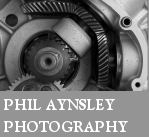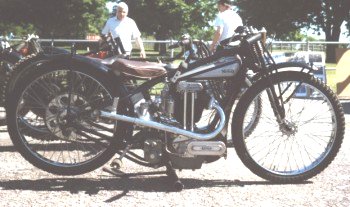


Refurbishing
Apologies for the dropsheets, paint tins and scattered detritus. More information...
The Machine Evolution - 4.
Yet another famous motorcycle manufacturer entered the dirt track sphere, with special works models.
It was the Norton company, but only a small number of these machines were manufactured, around twenty in fact, the majority
went to Australia. In England, Eric Langton and Ron Johnson had a period Norton-mounted and Stan Catlett too,
that voluble little Australian who was riding for Wembley. The Norton dirt track machine's general appearance was superb, and it was a matter of some surprise that
the famous firm did not cling more tenaciously to the rapidly growing market, although, of course, its activities
in road racing probably precluded this. But time marches on ... with the changing of many scenes and the world famous dirt Duggies, machines that
had previously been the cat's whisker, began a downward slide and a new machine era started. Towards the end of that 1930 season came the first signs of yet another revolution. Prior to this time,
Messrs. J.A. Prestwich had not concerned themselves very much with speedway racing, but Stanley Greening and
Wal Phillips, who was also an employee of the JAP factory in (North London, produced a new racing motor. The
speedway J.A.P., and later an assortment of JAP-powered singles, permanently forced the Kingswood breed off the
sunny side of the street. And so, the Golden Days of the speedway Douglas sadly came to an end. But those
snarling, fiery low-slung twins, the real thrill-makers of the tracks, that made many a pioneer famous, have always
been affectionately remembered by everyone who saw them in action ... blazing the speedway trail. The light JAP engine was mounted in a Comerford Wallis frame assembly and Wal Phillips made a spectacular
debut in early August, (1930) at Stamford Bridge with the new model. He won the Stamford Bridge Championship
Riband and in a whirlwind time he clocked a record of over 46mph. This clearly showed that the JAP engine was
the most efficient one yet produced for its particular purpose. Stamford Bridge therefore, by Wal's amazing effort,
secured the title of the fastest 4-mile track in the country and his speed also constituted a British and European
Mile Speedway record. However, in October Wal bettered his own record, turning the 440 yard circuit in 18.Ssecs.
- 47.87mph! The JAP motor dropped very conveniently into short wheel-base frames, like that of the Rudge, and lent themselves to a less spectacular but more effective technique of broadsiding, close to the white line, with a minimal angle of corrective lock. Shortest time around the tracks decided what won and what lost races, and the singles, in the unarguable language of the timekeepers stop watches, made the fastest times. The beautiful Jackson-Rotrax speedway machine which won the World Championship seven times. One of these machines was presented annually to the winner of Wimbledon's premier event, the FIM lnternationale. From then on it was a JAP engine in a 'something' frame for practically every rider and amazingly, after 46 years, the same set-up, but to a lesser degree, continues today with many riders. That universal adoption, albeit a creditable adoption, seemed to be the first stepin standardisation with which we are still faced with today - with the Jawa, the sport having become far too stereotyped. Nowadays, and for a considerable time too, there has been little to choose in outward appearance between one machine and another, apart from perhaps, colour schemes. Different makes of speedway machines certainly add extra glamour to racing, and apart from creating additional competitiveness, entertainment value is greatly increased. The first Eso speedway model to be seen in Britain appeared in the hands of that magnificent Swedish ace, Ove Fundin in early 1961. The Czech company gave him one, but he rode his JAP engined machine in all the important events. Alec Jackson Exports Ltd., in North London however, became the original UK distributor of Eso motors in 1965, but the following year, Barry Briggs became the sole UK concessionaire at his Southampton premises for I the complete Eso (or Jawa machine as it is now called). As rider-agent, Barry came into a load of teething troubles, but later, as these were overcome, he brilliantly demonstrated the machine's capabilities in no uncertain manner. The British Weslake emerged in the 1970's to compete well alongside the JAP and JAWA, but it is one from a pattern that had become standardised in the same way that the whole sport has become moulded into a single form. Committed to a rigid programme with a practically unvariable team and a pit full of machines, as alike as peas in a pod, there is little opportunity for promoters to provide variety in speedway today. Neither for all the various developments, etc., is there much improvement in the spectacle. It is certainly an amazing fact that speeds are only slightly faster than they were 47 years ago by just a few mph! The foot-forward style of riding, close to the white line, has robbed the enthusiasts of their one-time thrill, that full lock wide and wild technique, while payments on results in terms of points rather than on a Sprouts Elder-like ability to entertain to an impressively high degree, are all factors that have tended to kill the big thrills that the old-timers so gallantly gave, and so sadly seek to recapture.
But I suppose, as it must be with all things ... time still marches on. From its rough-and-tumble begriming, speedway racing has sorted itself out, to become a highly-organised sporting attraction, of its popularity, there is certainly no doubt!
